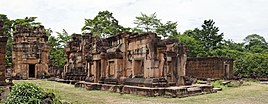
Back Propinsi Surin ACE محافظة سورين Arabic Сурын (правінцыя) Byelorussian Сурин Bulgarian চাংৱাত সুরিন BPY Província de Surin Catalan Surin Hū CDO Changwat Surin (lalawigan sa Thayland) CEB پارێزگای سورین CKB Surin (Provinz) German
This article needs additional citations for verification. (May 2015) |
Surin
สุรินทร์ (Thai) | |
|---|---|
From top; left to right: Prasat Ta Muen Thom, The Monument of Phaya Surin Phakdi Si Narong Changwang, Wat Burapharam, Surin City Pillar Shrine, Surin Elephant Round-up. | |
| Nickname(s): Mueang Chang (lit. 'City of Elephants') | |
| Motto(s): สุรินทร์ ถิ่นช้างใหญ่ ผ้าไหมงาม ประคำสวย ร่ำรวยปราสาท ผักกาดหวาน ข้าวสารหอม งามพร้อมวัฒนธรรม ("Surin. Home of large elephants. Beautiful silk and prayer beads. Rich in (stone) castles. Sweet radishes. Fragrant rice. Fascinating culture.") | |
 Map of Thailand highlighting Surin province | |
| Country | Thailand |
| Capital | Surin |
| Government | |
| • Governor | Suvapong Kitiphatpiboon (since October 2020)[1] |
| Area | |
| • Total | 8,854 km2 (3,419 sq mi) |
| • Rank | Ranked 22nd |
| Population (2019)[3] | |
| • Total | 1,396,831 |
| • Rank | Ranked 12th |
| • Density | 157/km2 (410/sq mi) |
| • Rank | Ranked 26th |
| Human Achievement Index | |
| • HAI (2022) | 0.5935 "low" Ranked 77th |
| GDP | |
| • Total | baht 73 billion (US$2.4 billion) (2019) |
| Time zone | UTC+7 (ICT) |
| Postal code | 32xxx |
| Calling code | 044 |
| ISO 3166 code | TH-32 |
| Website | surin.go.th |
Surin (Thai: สุรินทร์, pronounced [sù.rīn]; Northern Khmer: ซเร็น, pronounced [sren]; Kuy: สุลิน) is one of Thailand's seventy-seven provinces (changwat). It lies in lower northeastern Thailand, also called Isan. Neighboring provinces are (from west clockwise) Buriram, Maha Sarakham, Roi Et, and Sisaket. To the south it borders Oddar Meancheay of Cambodia. Surin covers a total area of 8,124 km2 (3,137 sq mi) from the Mun River in the north to the Dangrek Mountains in the south. The capital, Surin city, in the western central region province is 434 km from Bangkok.[6]
The area of present-day Surin has long history of human settlement which dates back to prehistoric times. Historically the region has been ruled by various powerful kingdoms including the Angkorian Khmer Empire, the Lao kingdom Lan Xang, and the Thai kingdom of Ayutthaya. Reflecting this history as part the greater geo-cultural area of Thailand known as Isan, Surin is ethnically diverse. The primary language is the Isan dialect of Lao. Speakers of Central Thai account for a small minority while nearly 50% of the population are ethnic Khmer. The remainder are speakers of various Lao languages and small tribal groups such as the Kuy and Nyah Kur.
The northeast provinces have traditionally been isolated, both physically and culturally, from the rest of Thailand and Surin is no exception. The vast majority of the province is rural and relatively poor. There is little industrial development with rice farming being the primary industry. Rice farmers supplement their income by cutting sugar cane, as construction laborers, or working in the local silk weaving trade.[7] Elephant capture and training is also an important industry in Surin. Approximately 25 percent of all the elephants in the kingdom are raised in Surin, predominantly by the ethnic Kuy people.[8]
Tourism is also important to the Surin economy. Elephants and scenery are increasingly seen as potentially lucrative by the provincial government which has attempted to make Surin a popular destination for international ecotourism.[8] Domestically, Surin has a reputation for its fine silk and silver beaded ornaments produced in tourist-focused villages such as Khwao Sinaring Handicraft Village. Local traders also conduct cross-border commerce with Cambodians through a border crossing at Chong Chom, 70 km south of Surin city.[9]
- ^ "ประกาศสำนักนายกรัฐมนตรี เรื่อง แต่งตั้งข้าราชการพลเรือนสามัญ" [Announcement of the Prime Minister's Office regarding the appointment of civil servants] (PDF). Royal Thai Government Gazette. 137 (Special 194 Ngor). 33. 24 August 2020. Archived from the original (PDF) on August 25, 2020. Retrieved 13 April 2021.
- ^ "ตารางที่ 2 พี้นที่ป่าไม้ แยกรายจังหวัด พ.ศ.2562" [Table 2 Forest area Separate province year 2019]. Royal Forest Department (in Thai). 2019. Retrieved 6 April 2021, information, Forest statistics Year 2019, Thailand boundary from Department of Provincial Administration in 2013
{{cite web}}: CS1 maint: postscript (link) - ^ รายงานสถิติจำนวนประชากรและบ้านประจำปี พ.ส.2562 [Statistics, population and house statistics for the year 2019]. Registration Office Department of the Interior, Ministry of the Interior. stat.bora.dopa.go.th (in Thai). 31 December 2019. Retrieved 26 February 2020.
- ^ "ข้อมูลสถิติดัชนีความก้าวหน้าของคน ปี 2565 (PDF)" [Human Achievement Index Databook year 2022 (PDF)]. Office of the National Economic and Social Development Council (NESDC) (in Thai). Retrieved 12 March 2024, page 82
{{cite web}}: CS1 maint: postscript (link) - ^ "Gross Regional and Provincial Product, 2019 Edition". <>. Office of the National Economic and Social Development Council (NESDC). July 2019. ISSN 1686-0799. Retrieved 22 January 2020.
- ^ "From Bangkok to Surin". Google Maps. Retrieved 12 May 2015.
- ^ Behnassi, Mohamed; Shahid, Shabbir; D'Silva, Joyce, eds. (2011). Sustainable Agricultural Development: Recent Approaches in Resources Management and Environmentally-Balanced Production Enhancement. Springer Science & Business Media. p. 188. ISBN 9789400705197.
- ^ a b Pongsak, Nakprada. "The 'Elephants Return to Homeland' Project Management for Provincial Economic Development in Surin province" (PDF). The Government of Thailand. Archived from the original (PDF) on 18 May 2015. Retrieved 12 May 2015.
{{cite journal}}: Cite journal requires|journal=(help) - ^ "Royal Thai Government website". Archived from the original on 2021-10-09. Retrieved 2015-05-12.
© MMXXIII Rich X Search. We shall prevail. All rights reserved. Rich X Search








